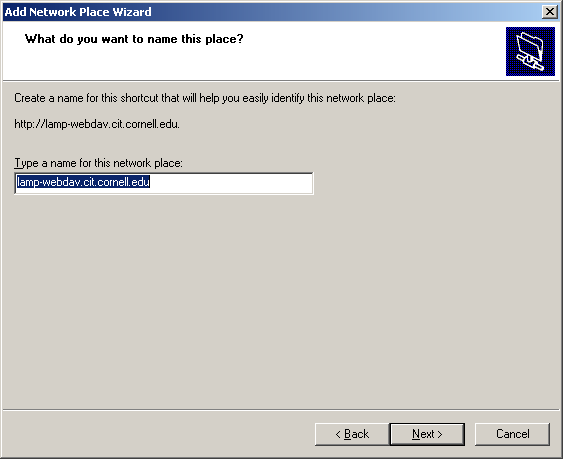What is WebDAV?
WebDAV is a file-transfer protocol, similar to FTP in that it is used to upload/download/modify files collaboratively on the internet. It is the access method of choice for the CIT-IS LAMP hosting environment, because it allows users to use their CUWebLogin credentials to get access to their LAMP accounts, while still keeping file ownership and permissions on the server side consistent, so multiple users can safely share access to and collaborate on a LAMP account.
WebDAV in Windows
The two popular options for using WebDAV in Windows are the Microsoft built-in DAV client, and WebDrive, a commercial offering with a lot of neat features.
WebDAV Clients vs. Browsers
WebDAV is based on HTTP, so while WebDAV URLs can be accessed in browsers like Firefox, Internet Explorer, and Safari, those browsers don't actually support the WebDAV protocol for actual uploading/downloading of files. What will usually happen if you visit a WebDAV share in a browser is that you'll see the contents of the WebDAV share served as if they were a webpage - such as getting the code for your index.php file, instead of the processed PHP output.
Using the Microsoft WebDAV Client
Important note for Vista users
Use Vista? Are you following these directions only to get a whole lot of "The folder you specified does not appear to be valid"? If so, try this hotfix to enable web folder support on Vista (Microsoft.com hotfix). Alternatively, try mapping to a drive letter instead of a web folder. Still experiencing issues? Please drop webservices-l a note.
1. Open My Network Places
If you have My Network Places on your desktop, double click the icon to open it.
If My Network Places is not on your desktop, open My Computer, and open My Network Places from the sidebar on the left hand side.
2. Add a Network Place
Click on "Add a Network Place" to add a new WebDAV share.
3. The Add a Network Place Wizard
Click Next to continue.
4. Choose type of Network Place
If you have multiple options, be sure to choose the "Choose another network location (Specify the address of a Web site, network location, or FTP site." option.
5. Enter the address of your DAV share
Here is where you enter the WebDAV URL you were provided at signup. This information is also available on the default splash page for your instance. It is usually just your instance's pre-production URL suffixed by -webdav, for example, http://lamp-webdav.cit.cornell.edu![]() .
.
You can visit your LAMP splash page and get this information from the Instructions for Using WebDAV area if you aren't sure.
6. Authentication Prompt
When you click next, you will be prompted for your NetID and your password, in this case your LAMP WebDAV key. Do not use your NetID password.
You can acquire your LAMP WebDAV key from the "davlogin" path at your WebDAV URL, which will be displayed in your authentication prompt, and is also available as a link from your splash page:
7. Acquire Key
After you visit your WebDAV's DavLogin URL, you will be provided with a long string that is your key. Select the key and copy it onto your clipboard.
8. Log In to Your DAV Share
Enter your NetID in the User name field and the DAV key you just acquired into the password field, and click OK, then Next.
9. Name Your New DAV Share
You can name your share whatever you like, the URL for it is already stored.
10. Your DAV Share is Now Available as a Folder
You can now open your DAV share just like it was any other Windows folder from your My Network Places screen. You can now drag and drop files to your LAMP account via DAV and interact with it as if it were a folder on your local machine. The first time you log in, you may be reprompted for your NetID and DAV key - just paste the key in again. Feel free to save the password - you will be prompted again when your key expires.
Using the Share
WebDAV keys are good for 8 hours (they are your CU Web Login session). If you have checked the "Save Password" option, you will be reprompted automatically when it is time to refresh your CU Web Login session. To continue using the share, simply repeat Step 7 and paste the new key into the authentication prompt's password field.











